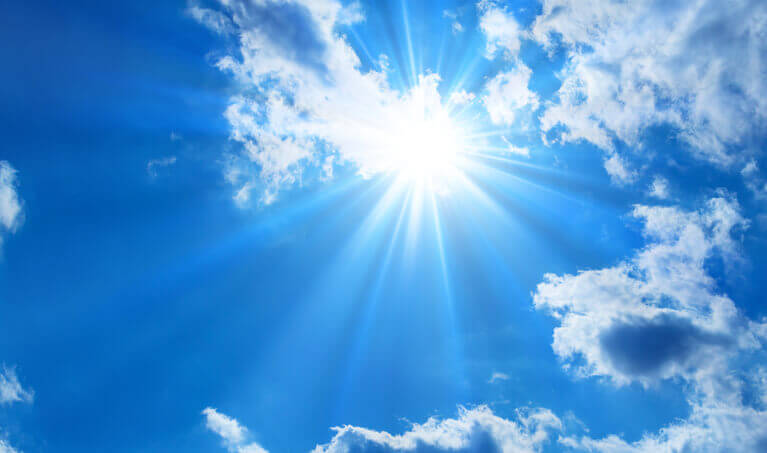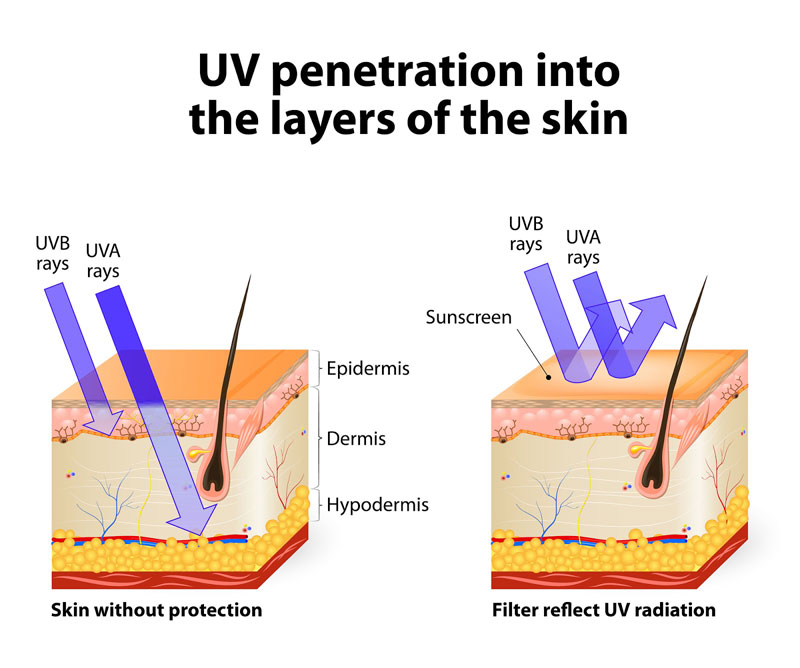Ultraviolet (UV) Radiation

What is Ultraviolet Radiation?
Ultraviolet (UV) radiation is a type of energy produced by the sun and by artificial sources, such as tanning beds. UV radiation is the main cause of melanoma and other skin cancers such as basal cell carcinoma and squamous cell carcinoma.
The sun’s UV rays can reach a person three ways: directly from the sun; scattered from the open sky; and reflected by the environment. The radiation level depends on a number of factors:
Time of day: UV radiation level is higher between 10am and 4pm.
Season of the year: UV radiation level is highest in summer.
Latitude: The closer to the equator, the higher the UV radiation levels.
Altitude: The higher the altitude, the higher the UV radiation levels.
Cloud cover: Clouds can scatter and reflect UV radiation, which means UV radiation level can be high even on a cloudy day.
Reflection off surfaces: Surfaces like water, sand, snow, and pavement scatter and reflect UV radiation, leading to an increase in radiation level.
What Are the Types of UV Rays?
There are three types of UV radiation from the sun: UVA,UVB, and UVC. All can cause skin and eye damage.
UVC is the most dangerous type of UV radiation, but fortunately, the sun’s UVC is absorbed by our atmosphere before it reaches the earth’s surface. However, there are other sources of UVC, such as in arc welding, from which workers need to protect themselves with face-shields, protective clothing, and eye protection.
UVB is the second most potent type of UV radiation. It penetrates the top layer of the skin and is the primary cause of sunburns (remember “B” for burns). UVB is the main cause of basal cell and squamous cell carcinoma as well as melanoma. Note: UVB is also responsible for making vitamin D in your skin, and most people receive enough incidental sunlight on their skin—even with sunscreen use—to produce the needed amount of vitamin D. Additionally, certain foods can supply vitamin D.
UVA is the least potent type of UV radiation but most abundant. 95% of the UV light that reaches us is UVA. It does not increase your vitamin D levels. UVA penetrates clouds and car windows. We’re exposed to it year-round. UVA radiation penetrates deep into the skin, and causes wrinkling, leathering, and premature aging of skin (remember “A” for aging). It makes UVB-induced damage worse, and increases your risk for developing melanoma and other skin cancers.

The UV Index
The UV Index was created to help you make informed decisions about how much time you should spend in the sun and what protection you should use. It tells you how strong the sun’s UV rays will be. The higher the UV Index, the greater the strength of the sun’s UV rays and the faster you may burn.

The index predicts the risk of UV overexposure on a scale of 0 (minimal risk) to 11+ (very high risk). The forecast considers latitude, elevation, weather conditions, time of year, and the ozone levels in your region. The index is based on a Type 2 Fitzgerald skin type (fair skin, burns easily, tans minimally; learn more about Fitzgerald Skin Types). The chart above shows the levels of the UV Index and what you should do to protect yourself.
Check Your Local UV Index
Enter your city or zip code and see what your current UV index is for your location.
The UV Index Scale
The UV Index scale used in the United States conforms with international guidelines for UVI reporting established by the World Health Organization. [source: EPA]
UV Index 0-2 means minimal danger from the sun’s UV rays for the average person. Most people can stay in the sun for up to one hour during peak sun (10 am to 4 pm) without burning. However, people with very sensitive skin and infants should always be protected from prolonged sun exposure.
UV Index 3-5 means low risk of harm from unprotected sun exposure. Fair-skinned people, however, may burn in less than 20 minutes. Wearing a hat with a wide brim and sunglasses will protect your eyes. Always use a broad-spectrum sunscreen with an SPF of at least 30, and wear long-sleeved shirts when outdoors.
UV Index 6-7 means moderate risk of harm from unprotected sun exposure. Fair-skinned people, however, may burn in less than 20 minutes. Wearing a hat with a wide brim and sunglasses will protect your eyes. Always use a broad-spectrum sunscreen with an SPF of at least 30 and wear long-sleeved shirts when outdoors. Remember to protect sensitive areas like the nose and the rims of the ears. Sunscreen prevents sunburn and some of the sun’s damaging effects on the immune system. Use a lip balm or lip cream containing a sunscreen.
UV Index 8-10 means high risk of harm from unprotected sun exposure. Fair-skinned people may burn in less than 10 minutes. Minimize sun exposure during midday hours of 10 am to 4 pm. Protect yourself by liberally applying a broad-spectrum sunscreen of at least SPF 30. Wear protective clothing and sunglasses to protect the eyes. When outside, seek shade. Don’t forget that water, sand, pavement, and glass reflect UV rays even under a tree, near a building or beneath a shady umbrella. Wear long-sleeved shirts and trousers made from tightly-woven fabrics. UV rays can pass through the holes and spaces of loosely knit fabrics.
UV Index of 11+ means a very high risk of harm from unprotected sun exposure. Fair skinned people may burn in less than 5 minutes. Outdoor workers and vacationers who can receive very intense sun exposure are especially at risk. Minimize sun exposure during midday hours of 10 am to 4 pm. Apply broad-spectrum SPF 30+ sunscreen every 2 hours, more frequently if you are sweating or swimming. Avoid being in the sun as much as possible and wear sunglasses that block out 99-100% of all UV rays (UVA and UVB). Wear a hat with a wide brim which will block roughly 50% of UV radiation from reaching the eyes.
How Do I Keep Myself Safe From All the Different Kinds of UV Light?
Using a broad-spectrum sunscreen with an SPF of 30 or higher that is specifically designed to block the effects of both UVA and UVB—and ensuring that you are applying and reapplying appropriately (every 2 hours or after exposure to water)—protects your skin and reduces your risk of developing melanoma and other skin cancers. By arming yourself with sunscreen, protective clothing, and the right sunglasses, you can reduce your risk of melanoma and other skin cancers while enjoying outdoor activities.

